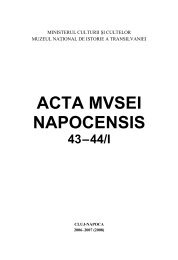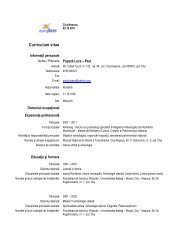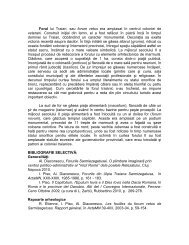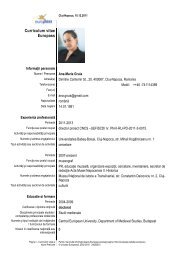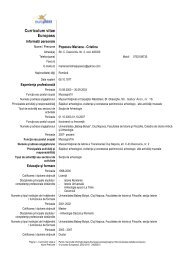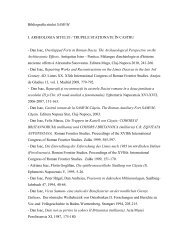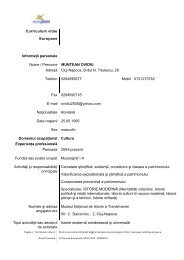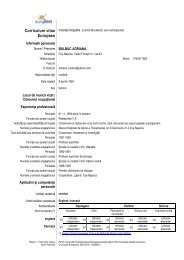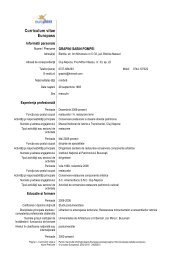41-42/I – Archeology - Muzeul Naţional de Istorie a Transilvaniei
41-42/I – Archeology - Muzeul Naţional de Istorie a Transilvaniei
41-42/I – Archeology - Muzeul Naţional de Istorie a Transilvaniei
Create successful ePaper yourself
Turn your PDF publications into a flip-book with our unique Google optimized e-Paper software.
36<br />
Vitalie Bârcă<br />
competition represented by the cheaper wheat brought from Egypt on the markets in the<br />
Mediterranean and Circumpontic basin, we must say that this theory has its weak points,<br />
as well. Thus, until now, just like Ju. G. Vinogradov noted 17 , the <strong>de</strong>fen<strong>de</strong>rs of this theory<br />
have brought no proof for the i<strong>de</strong>a of a well-coordinated or competitional protectionist<br />
economic policy applied. As the same author justly remarked, there are no data to prove<br />
that Pontic wheat was more expensive than the Egyptian one. On the contrary, up to now<br />
nobody has rejected M. I. Rostovcev’s thesis, based on the information from several<br />
epigraphic sources, according to which in the Hellenistic period the <strong>de</strong>mand excee<strong>de</strong>d<br />
the offer on the wheat market 18 . However, the given opinion stands on a couple of solid<br />
arguments that have been exposed not only in ol<strong>de</strong>r works, but also in a more recent<br />
study 19 , which makes certain aspects of it be taken into account.<br />
As for the fourth theory, which blames the Sarmatians for the <strong>de</strong>struction of<br />
Scythia, it is supported by a large number of researchers 20 , who rely to a great extent on<br />
information from written sources. A novelty in this approach is the establishment by Ju.<br />
A. Vinogradov, K. K. Marčenko and E. Ja. Rogov of two successive Sarmatians attacks<br />
in the north-pontic territories to the west of the Don river 21 . According to this, the first<br />
Sarmatian attack took place right at the boundary between the IV th -III rd centuries B.C. or<br />
at the beginning of the III rd century B.C. and was aimed exclusively against the<br />
Scythians 22 . After this blow against the Scythians, there was a quiet period that lasted<br />
about 30 years. The second attack of the Sarmatians occurred between the ‘70s-‘60s of<br />
the III rd century B.C. and was directed against the se<strong>de</strong>ntary population to the north of<br />
the Black Sea. The authors believe that most of the Greek and barbarian settlements<br />
ceased to exist precisely as a consequence of this attack not only in the lower Don,<br />
Dnepr, Bug, and lower Dnestr area and north-western Crimea 23 , but also in the European<br />
part of Bospor. The same authors explain the lack of material traces belonging to the<br />
Sarmatians in the north-pontic area to the west from the Don river by the fact that they<br />
ran their <strong>de</strong>vastating blows from the steppes between the Don and the Volga or the<br />
Kuban region 24 .<br />
The arguments of those who criticize this opinion, whose main representatives<br />
are S. V. Polin and A. V. Simonenko can be brought down to three theses. The first<br />
refers to the events accounted for by Diodor of Sicily (II, 43, 7), which, in their opinion,<br />
17<br />
Ju. G. Vinogradov, op. cit. (n. 2), p. 107.<br />
18<br />
Cf., in this sense, Ju. G. Vinogradov, op. cit. (n. 2), p. 107 and all the bibliography.<br />
19<br />
I. Brujako, Despre evenimentele... (n. 3), p. 75-77 consi<strong>de</strong>rs this factor as being parallel and<br />
in<strong>de</strong>pen<strong>de</strong>nt from the Sarmatic and Celtic one.<br />
20<br />
M. I. Rostovcev, Amaga... (n. 2), p. 60 sqq.; i<strong>de</strong>m, Ellinstvo i iranstvo... (n. 2), p. 43, 127 sq.; M.<br />
Rostovtzeff, Iranians and Greeks... (n. 2), p. 85, 139; M. Rostowzew, Skythien... (n. 2), p. 405, 605; D.<br />
A. Mačinskij, op. cit. (n. 7), p. 30-54; A. N. Šeglov, op. cit. (n. 7); K. F. Smirnov, O načale... (n. 7), p. 191-<br />
196; i<strong>de</strong>m, Sarmaty i utverž<strong>de</strong>nie... (n. 7); V. N. Kostenko, op. cit. (n. 7); V. E. Maximenko, Savromaty i<br />
sarmaty... (n. 7), p. 18, 43-49, 116-129; i<strong>de</strong>m, Sarmaty... (n. 2), p. 74-81. among more recent works, see<br />
K. K. Marčenko, op. cit. (n. 2), p. 70-80; Ju. A. Vinogradov, K. K. Marčenko, E. Ja. Rogov, op. cit. (n. 2), p.<br />
93-103; Ju. G. Vinogradov, op. cit. (n. 2), p. 104-124.<br />
21<br />
Ju. A. Vinogradov, K. K. Marčenko, E. Ja. Rogov, op. cit. (n. 2), p. 98-101.<br />
22<br />
I. V. Brujako, Ot dioramy k panorame... (n. 3), p. 328 consi<strong>de</strong>rs that the Sarmatic attack was not<br />
directed against the nomadic Scythians that were constantly moving, but against the settlements in<br />
which most of Scythia’s economic and thrift potential was concentrated.<br />
23 rd<br />
Towards the middle III century B.C. life ceases to exist in virtually all ancient settlements in the lower<br />
Dnestr area (I. Brujako, Despre evenimentele... (n. 3), p. 64).<br />
24<br />
Ju. A. Vinogradov, K. K. Marčenko, E. Ja. Rogov, op. cit. (n. 2), p. 101; Ju. G. Vinogradov, op. cit. (n. 2),<br />
p. 122-123; V. M. Klepikov, A. S. Skripkin, Rannie sarmaty v kontexte istoričeskih sobytij Vostočnoj Evropy,<br />
Donskie drevnosti 5, 1997, p. 38 consi<strong>de</strong>rs that in the III rd century B.C., the Sarmatians were responsible<br />
for the <strong>de</strong>vastating incursions in the north-pontic territory to the west of the Don, in the steppes between<br />
the Don and the Volga.



